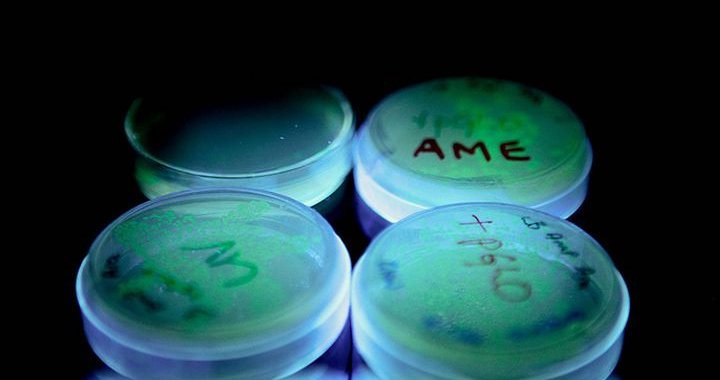
Focus: Bioart - Artists in Science Labs
05/08/2014
What do Petri dishes, different flasks and vials, microscopes and other science lab equipment have to do with art? Not much, some might say. Nevertheless, in recent years there has been a growing number of artists who, instead of the more traditional art mediums, are utilising tools, techniques and materials usually used in the biosciences as their means of expression. The artistic practices of these artists include a wide range of biological materials, such as bacteria, human and animal tissues, plants and other living matter. Many of the artists have moved from the artist’s studio into the science lab, where they often work in close collaboration with scientists. These artists tend to – once again, and maybe even more than ever – to push boundaries and to challenge the common understanding of what is art, provoking in some people the eternal question of – Is it art?
The most widespread definition for this field of art is “bioart”, but it often also goes under other related names like “biotech art”, “transgenetic art” and “genetic art”, all of which signifies the vast diversity in the field in terms of mediums used as well as conceptual aspects. The boundaries between the categories can be rather fluid, and often tend to overlap one another. Therefore, it can sometimes be difficult to classify the works and to put them into one box or another. Many of the artists work in an interdisciplinary manner by employing biological “wetware” in their practice, and combining it with more technology-based practices like artificial life and robotics, and the emerging area of synthetic biology, in which engineering principles are applied to biology, thus making it possible to design virtually new life forms. In very general terms, artists working with bioart can be divided into two categories – those that are preoccupied with human biology, and those who focus on the environment, nature, plants and animals, and other living organisms; although these two categories often do merge.
The intersection of art and the biological sciences
In spite of its existence for several decades already, bioart still takes up relatively little room in exhibition spaces – and in contemporary art in general – and it hasn’t yet reached the ears and eyes of many otherwise art-loving individuals. For the most part, bioart has led a quiet life behind the walls of university laboratories and medical and natural history museums. However, in recent years bioart has begun to resurface more frequently in new media art festivals, like Ars Electronica in Linz, Austria (Ars Electronica 2014 will take place September 4 – 8), which is one of the largest of its kind, and also in some museums and galleries (although only a few of them have been commercial). Most of the venues showing this kind of art are still connected to large scientific institutions.
Part of the explanation for this is attributable to the fact that the display and maintenance of artworks in which living biological materials have been used can be technically demanding, requiring the right conditions and laboratory equipment within the gallery or museum space – not to mention the legal and ethical issues that, inevitably, arise when living matter is utilised in art (e.g., disposal issues after the exhibition). Many of the works in the field are also performative and process-based, and therefore, difficult to preserve. Consequently, the majority of the exhibitions only present the remnants of the actual projects – in the form of different kinds of documentation, such as photos, film, video and text – and only rarely are there a few physical objects that employ living matter.
The Science Gallery in Dublin – an initiative of Trinity College Dublin, is one of the venues which, since 2008, has hosted a large number of exhibitions, workshops and research projects; it has also offered a range of educational programs that have the goal of merging art and science. In past years, The Science Gallery has hosted various outstanding exhibitions featuring some of the major names within the field. In 2012 the Global Science Gallery Network was launched, with plans to expand to several other countries around the world.

Niki Passath “A Robot As a Tourist in the Subarctic”. From the Field_Notes – Cultivating Ground workshop. September 2011. The robot out for a walk in the subarctic landscape, near the Kilpisjärvi Biological Station. Niki Passath is based in Austria, and is engaged with the sculptural conditions of robots, the idea of artificial life, and the relationship between human/machine and the surrounding environment. Courtesy of Nikki Passath
A number of bioart clubs and societies have also emerged, actively building international networks of artists and scientists, and organizing workshops, projects and residency programs. One of them is The Finnish Society of Bioart, established in 2008 in Kilpisjärvi, and today based in Helsinki. It supports and promotes cooperation between artists in various fields and scientists who work within the natural sciences. The primary focus of the Society is nature and the environment. Among their initiatives is Ars Bioarctica, which is a long term project in cooperation with the Kilpisjärvi Biological Station, a division of the Faculty of Biosciences of the University of Helsinki. The focus of the project is the Arctic environment – its unique nature, biology and ecology, and how it is influenced by environmental- and climate changes.
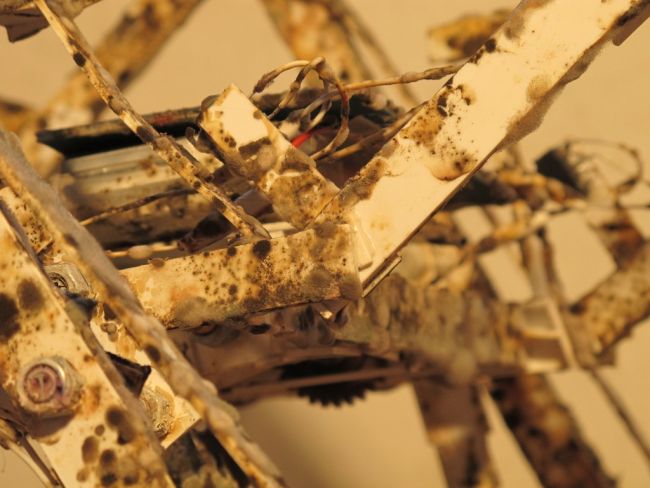
Niki Passath “the tourist – infected with moss – part 1-03”. From Field_Notes – Cultivating Ground. September 2011. A large amount of different fungi and bacteria have grown on the structure and surface of the robot after its return home. Nature has infected the robot. Courtesy of Niki Passath
The latest activities within the context of Ars Bioarctica include the field laboratory Field_Notes, in which a group of international artists and scientists have the opportunity to collaborate by jointly doing theoretical and practical work, exploring the local area, and gathering raw material and data. The Finnish Society of Bioart has managed to engage in its projects some of the leading figures working within the fields of art and science, and to bring together practitioners with various backgrounds.
Some of the initiatives – like the different workshops, do-it-yourself bio-labs and bio-hacking collectives – are often open to the general public, with the goal of demystifying science. The initiatives' intention is to make the scientific processes and technologies more accessible and understandable to the layman, which, in turn, encourages people to reflect on the issues that arise along with the rapid development of the life sciences and their growing influence on our lives.
pavillon_35 “Yeastograms”. A DIY bioart workshop was held in cooperation with Pixelache and the Finnish Society of Bioart in Helsinki in 2013. The participants had the opportunity to work with the yeastogram method, developed by artists and scientists from the bioart club pavilion_35, Vienna. The method allows for the creation of live images consisting of yeast cells, and is done in a photography-like process. Yeast micro-organisms have a cell nucleus, therefore their structure is closer to more advanced beings than that of bacteria. Yeast is an important model organism for biological and biomedical research, and has been used in research for centuries. The purpose of the workshop was to explore the utilization of living organisms in the creation of art and expression through the use of amateur biological techniques. Courtesy of pavilion_35
Access to laboratory equipment, materials and funding have always been among the major challenges faced by artists working with bioart. This means that when artists need to use regular science labs, they are often only able to work in them on weekends or late at night. Moreover, they are highly dependent on the goodwill of the biologists in allowing the artists to use the laboratories, as well in rendering their assistance and sharing their knowledge. Recently the artists' working conditions have improved, however, due to the increasing number of science labs that are beginning to open their doors to artists; in addition, much of the biotechnology equipment and materials have become cheaper and more accessible. Most laboratories are still connected to institutions, but a few independent ones have also been established, giving the artists the opportunity to obtain hands-on experience with biotechnologies.
Within Europe, Finland is definitely one of the places where the field of art and science is booming at the moment. Moreover, Finland has also nurtured one of the leading pioneers of bioart – Antero Kare, who has been growing “living” sculptures and paintings of microbes since the 1980s. In 2012, Biofilia – Base for Biological Arts was launched under the School of Arts, Design and Architecture at Aalto University in Helsinki, which is the first fully functional biological lab within an art department. It was established in cooperation with Ionat Zurr and Oron Catts – two other pioneers in bioart. The Biofilia Laboratory provides artists, students and researchers with the opportunity to engage with life sciences exclusively for artistic purposes, and offers a platform for interdisciplinary research and education. Its aim is to also create discussion around the subject of the life sciences within a broader cultural and sociological context.
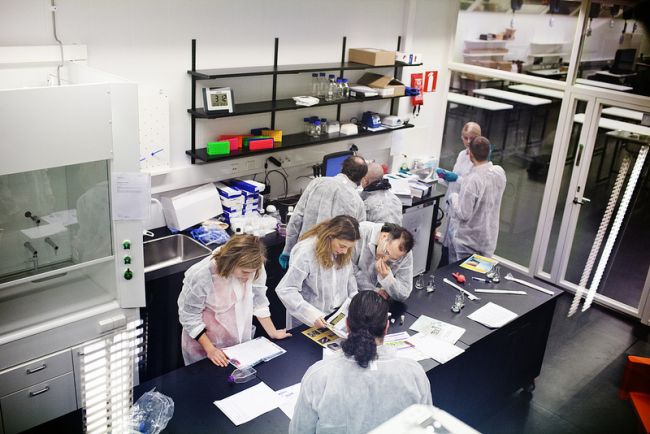
Ionat Zurr with students at the Aalto Biofilia Lab. Photo: Susanna Kekkonen. Courtesy of Aalto Biofilia and Susanna Kekkonen
The pioneers – engineering life
Science and technology have always been subjects of interest and fascination among artists, either as a source of inspiration or as a new means of expression. Some artists have even engaged in experiments themselves by exploring the latest scientific methods and inventions, driven by the curiosity to explore nature and life. Bioart is a part of a larger field of art that lies in-between technology and science. Like science itself, bioart is a continuously evolving field that responds to the latest scientific and biotechnological achievements and the shifting discourses within science, as well as being subject to diverse aesthetic influences. It would be difficult or even impossible here to trace the exact origins of bioart, or when humans began using living matter to create art.
Humans have always possessed the desire to be able to control and manipulate nature, manifesting itself through centuries of animal- and plant breeding. There have even been many attempts to create new life by artificial means, or to bring artificial things to life. We can find countless examples of this in science, but also in art. Just consider the myth of Pygmalion, who created a statue that was brought to life. Nevertheless, such attempts have also been surrounded by taboos and accusations of “man playing God”.
Today, the ability and desire to interfere with nature and life has reached new heights with genetic engineering, cloning and synthetic biology, all of which have also provided artists with new areas of exploration.
The photographer and plant breeder Edward Steichen is regarded today as the first true bioartist. In the 1930s and 1940s, he began experimenting with new techniques of plant hybridisation, but he did it solely as an art form. In 1936, his genetically manipulated delphiniums were presented as “art” at the MoMA exhibition Edward Steichen’s Delphiniums, thus expanding the limits of art. Many artists have since followed in the footsteps of Steichen, among them George Gessert, who once again took up plant breeding as art in the 1980s.
Among other pioneers of bioart we find Joe Davis, who is regarded today as the grandfather of bioart. Along with the emergence of new techniques of DNA manipulation, Davis began to engage with molecular biology and to employ the new tools in his work. He was particularly interested in the genetic manipulation of bacteria in order to create “living codes”. Together with molecular biologists, in 1986 Davis created his famous work Microvenus, with the goal of creating a carrier of messages that could travel through space and communicate with extraterrestrial life. Microvenus was created by recombining DNA through a standard method of molecular biology using E. coli bacteria, allowing for the transfer of genetic material between organisms. Today it is a widely used practice among many bioartists. In this case, DNA functions as a storer of information, something which still is a subject of scientific research. The development of DNA recombination techniques marks a turn in molecular biology, leading to the possibility of creating new forms of life by mixing genetic material from different organisms.
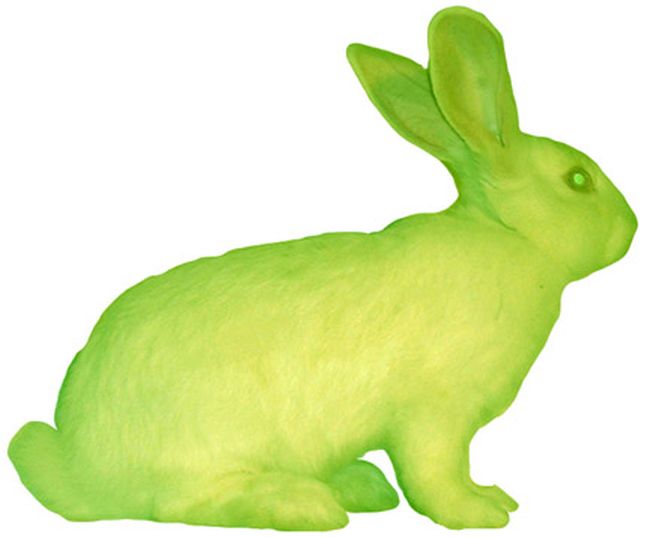
Eduard Kac “GFP Bunny”. 2000. Courtesy of Eduard Kac
Eduard Kac was another leading figure in bioart whose work still continues to influence contemporary bioartists. Like Davis, Kac was interested in transgenetics. His most iconic work could be said to be GFP Bunny – a transgenic rabbit named Alba. With the help of French scientists, Kac created a “luminescent” rabbit by infusing luminescent genes from a jellyfish into an albino rabbit. The rabbit would thus glow green under blue light. The project created quite a stir, although the method is quite common in a scientific context.
Eduard Kac “Natural History of the Enigma”. 2003-2008. Courtesy of Eduard Kac
With the project Natural History of The Enigma, Kac once again took up plant breeding in the context of art, but this time with a different approach than that of Steichen and Gessert. Kac created a new life form, “Edunia”, which he described as a “plantimal” – a genetically engineered petunia flower that was a hybrid of plant and human DNA. The human DNA was extracted from Kac’s blood and transferred into the plant. The human DNA is present in the red veins of the flower. The project's intended goal was to show the contiguity of life between different species.
The aforementioned Ionat Zurr and Oron Catts are two more names that are impossible to avoid in the context of bioart. They were one of the pioneers in the use of tissue culture and tissue engineering within their artistic practice, and have been active since the early 1990s with their project – the Tissue Culture & Art Project (TC&A).
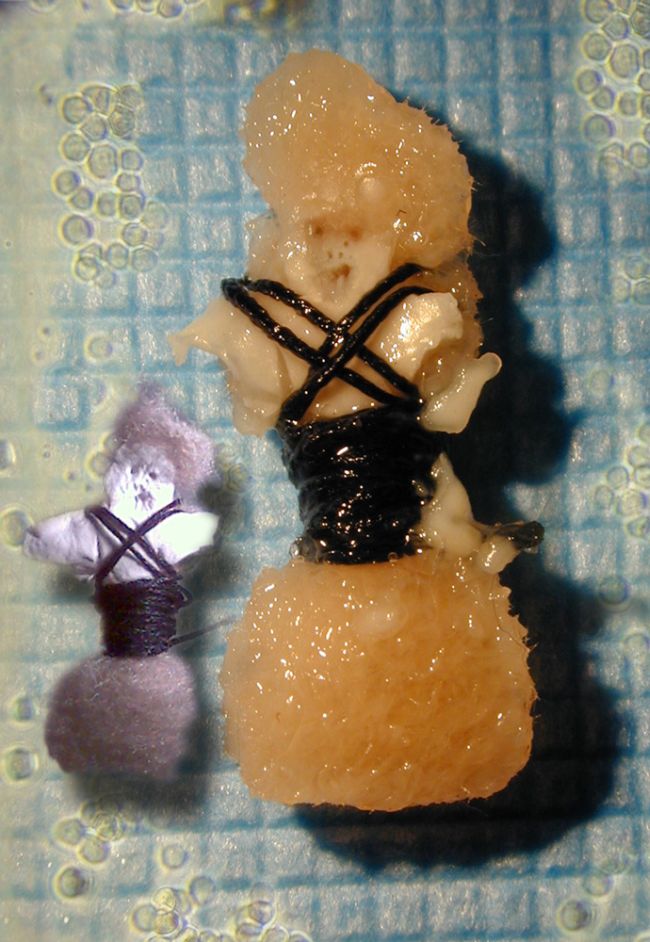
The Tissue Culture & Art Project “Semi-Living Worry Dolls”. 2000. Courtesy of The Tissue Culture & Art Project
The main subject of their work has been something that they define as “semi-living” objects – sculptures grown from living tissue, and include such projects as Semi-Living Worry Dolls and Disembodied Cuisine. The first of these was based on the legend of Guatemalan Worry Dolls, which are said to be able to solve children’s worries during the night. It is made up of seven small, doll-like “flesh” sculptures that have been grown in a bioreactor and that consist of different types of human cells that have multiplied around a biodegradable polymer structure. Among the venues in which this project has been shown is the Science Gallery in Dublin. The display was ended by a “killing ritual”, which has now become a part of most shows by TC&A.
The second project, a performative installation, was an attempt to produce meat without the killing of animals, thereby highlighting the problems posed by massive industrialized farming. During the course of the project, a “steak” was grown from muscle cells taken from a frog, and at the end of the project, the steak was cooked and served to a circle of invited guests who had volunteered to taste it. The culinary experience was, allegedly, rather questionable.
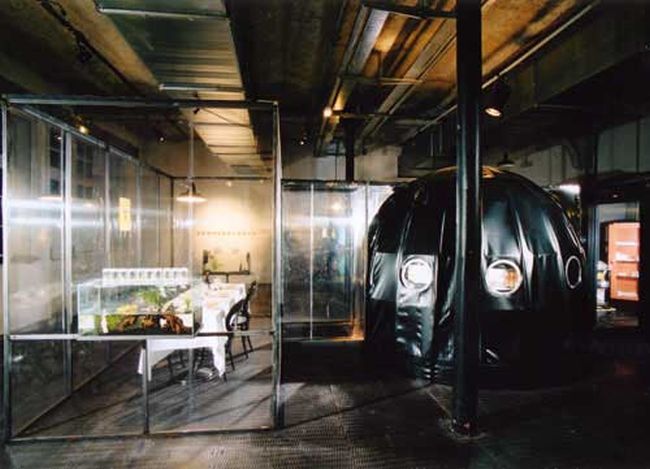
The Tissue Culture & Art Project “Disembodied Cuisine”. 2003. The project was part of the exhibition L’Art Biotech, in Nantes, France. Courtesy of The Tissue Culture & Art Project
Through its works, TC&A raises a large number of ethical questions concerning the human manipulation of life, the creation of alternative life forms, and our supposed superiority over other life forms. According to the hype surrounding genetics, life is equal to the genetic code, and therefore, the genetic code is also the determining factor in what constitutes a human being; this then is at the core of the dilemma inherent to bioart – is the use of living organisms, with the goal of creating art, ethically justifiable?
Ionat Zurr and Oron Catts were also among the initiators of another iconic institution within bioart – the SymbioticA artistic laboratory, which is located at the School of Anatomy and Human Biology at the University of Western Australia, in Perth. Since its founding in 2000, SymbioticA has undoubtedly been one of the leading driving forces behind the building of the bridge between art and science, which includes such disciplines as human biology, bio-engineering, tissue-engineering, neuroscience, plant biology and ecology. SymbioticA hosts an extensive on-going residential programme, backs many projects (a few of which are rather controversial), holds numerous exhibitions in which some outstanding artists have participated, and works in broad collaboration with other institutions around the world.
Stelarc “Ear on Arm”. Courtesy of Stelarc
TC&A is also behind a collaborative project with the renowned Australian performance- and body artist, Stelarc, who has been carrying out experiments on his own body using different mechanical prosthetic devices and biological implants. Stelarc has proclaimed himself a living cyborg – a hybrid of nature and culture, of man and machine. In his famous project, Extra Ear, Stelarc began exploring tissue engineering. It took several years to develop the project, which culminated with the Ear on Arm project – through a slow and demanding process, an ear was constructed on his arm. In collaboration with Stelarc and SymbioticA, TC&A created the Extra Ear ¼ project, in which a miniature replica of Stelarc’s ear was grown out of human and animal cells. Through his work, Stelarc challenges and extends the definitions of living and non-living, of human and non-human, as well as the limits of the human body – the body is infinitely mouldable and extendible, a body in process, shaped by technology and culture.
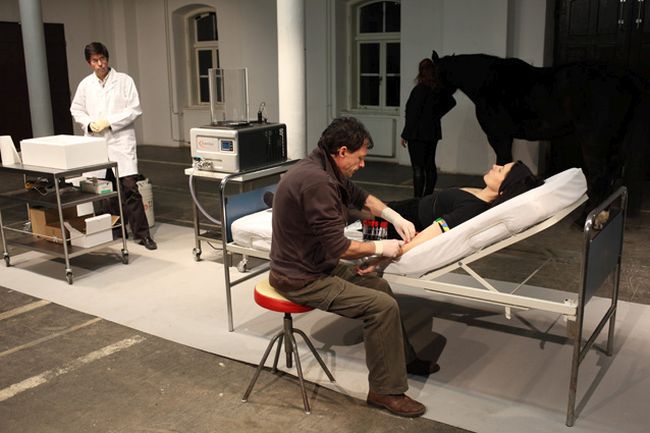
Art Orienté Objet “May the Horse Live In Me”. 2011- May. Performance at Kapellica Gallery, Ljubljana, Slovenia. Photo: Miha Fras. Courtesy of Art Orienté Objet. Performance and medical self-experiment with blood brother-hood that goes beyond species boundaries
Bioart has attracted growing interest among body artists, including artists like Orlan, Kira O’Reilly, and the artist duo of Art Orienté Object. Like many bioartists, they employ their body in their artistic practice. In body art, the artist's own body serves as both a medium and living matter to be used for artistic expression. Through subjection to modification and manipulation, the body virtually becomes a work of art itself. There are many parallels between the two fields, which also deal with some of the same conceptual issues.
All of these examples indicate that, now more than ever, artists seem to be occupied by life and the definition of life. Using a wide range of biological materials and biotechnological methods, bioartists are capable of creating virtually living art. With their work, artists address many essential questions concerning the most recent developments in the life sciences, among them being some of the following: how today's science affects human life and our environment; the consequences of human attempts to manipulate life and nature through genetic engineering, cloning, and animal and plant breeding; genetically engineered food and synthetic biology; the creation of transgenic organisms and new life for medical needs; and the possible future effects of all of the above.
Searching for solutions
Some of the artists involved with science face its development with curiosity, burning enthusiasm, and faith in innovation, all in the belief that the advancement of science and technology will be able to improve our lives; whereas others have a more critical approach, and question the impact of recent developments in science on the future of humanity and our environment. Even though today such a critical approach is more relevant than ever, it has its roots in the eternal fear that has, at all times, accompanied technological and scientific progress. It thrives in literature and science fiction films in which scientific experiments have gotten out of hand and technology runs amok, usually in the embodiment of monsters, mutants, robots, deadly viruses and other unforeseen outcomes, all due to irresponsible human activity.
The relationship between humans and technology has always been ambivalent, and it is subject to the permanent reconsideration that follows along with the evolution of science and technology; it also usually involves a shifting of views regarding nature and life as such.
Today bioart seems to be taking a new turn, with artists beginning to become directly involved in, and participating in, the processes of scientific research and innovation. There is an endeavour to create a constructive dialogue between artists and scientists. The focus has shifted to how artists are actually able to contribute to scientific research, and how they may even open the eyes of the scientists to new fields of research and new solutions to various problems.
Some artists are even taking on the role of inventor and designer, performing research and experiments that could potentially offer solutions for some of the problems we will be facing in the future, and generating new ideas for inventions that could maybe improve our lives.
Natalie Jeremijenko “Butterfly Bridge”. Initiated in 2010. Courtesy of Natalie Jeremijenko
In her own work, the artist, engineer and inventor Natalie Jeremijenko engages with such subjects as the environment, plants, and human life and health – particularly in an urban context – as well as with the human and animal interface. Her latest project, Farmacy, is an urban farming system designed to improve environmental health and biodiversity; it also aims to produce new types of food in the challenging urban environment. The project includes Butterfly Bridge, which is an invention with the purpose of helping butterflies navigate urban settings by luring them away from dangerous traffic with the aid of specially constructed bridges of flowers and plants.
Natalie Jeremijenko “AgBags”. Initiated in 2010. Courtesy of Natalie Jeremijenko
Another part of the project is AgBags, in which the public is invited to participate in an urban gardening experiment that supports pollinators, improves air quality, and explores flower based foods. Flowers are known to be highly dense with nutrients. The project consists of inexpensive, low-maintenance systems that can be easily integrated into existing urban structures.
Laura Beloff “A Unit”. 2012. Courtesy of Laura Beloff and the Finnish Society of Bioart
The environment, plant life and human-plant relationships in a techno-organic world are the main subjects of interest for the artist and researcher Laura Beloff. Her work, A Unit, was initiated as an on-going project to investigate the beneficial impact of the natural environment on human health and the impact of environmental changes on organisms. A Unit is designed to house a genetically modified plant or some other post-biological, human-constructed plant, and meant to be worn as a miniature green environment. It has been designed as a training device for forming a relationship with the organic side of nature in a situation when both humans and nature have been artificially modified or constructed. The research is directed towards urban planners, architects and the health sector.
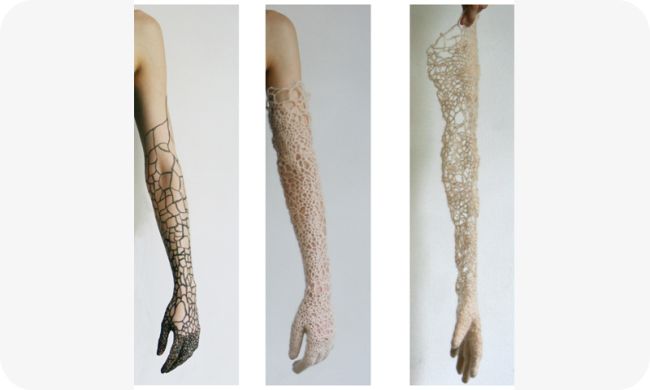
Sonja Bäumel “Crocheted Membrane”. 2008/09. Courtesy of Sonja Bäumel
Sonja Baümel works in a field somewhere in-between art, science, fashion and design. Her focus is the human skin and its potential for something new. Baümel explores the exceptionally rich living universe of bacteria that naturally lives on the surface of human skin. In this way she attempts to make people aware of the fact that we are hybrid super-organisms. Each individual has a unique and complicated micro-cosmos of bacteria on his/her skin, existing and transforming in symbiosis with its surroundings, and actually challenging the perception of who we are as individuals. Among other issues that Baümel examines is how these bacteria could be used to create new kinds of textiles and items of clothing that would react to our body temperature and the outside environment. The clothing would serve as a living layer of the body, interacting between the individual wearing it and the surrounding environmental conditions.
Read in archives: An interview with Amsterdam- and Vienna-based bio-artist Sonja Bäumel
On a different side of the bioart spectrum, with his latest project, Foood, the artist Gints Gabrāns takes up the challenge of procuring an increasingly large food supply for the continuously growing world population. A lack of food is an ever-increasing problem, a consequence of overpopulation and environmental changes that are causing the disappearance of both water sources and areas suitable for farming; there is an urgent need to find new sources of food. Gabrāns has offered up a solution with his genetically modified bifidobacteria, which have been given the ability to synthesize an enzyme that can break down cellulose; celluslose forms the cell walls of plants, and is otherwise indigestible by humans. These enzymes would allow for more efficient use of food sourced from the plant world, in addition to creating new food resources – such as even wood and paper.
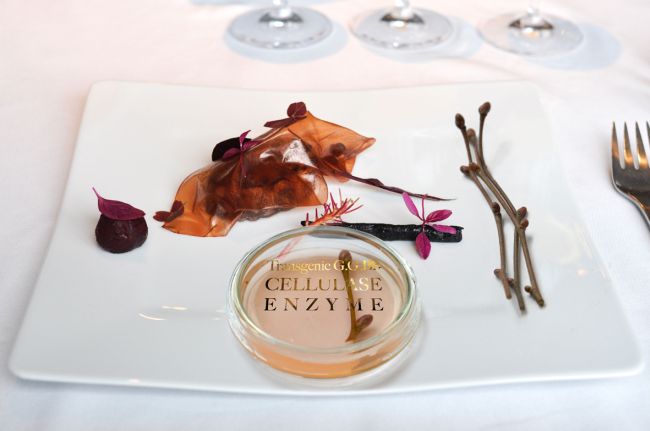
Gints Gabrāns “Foood”. Courtesy of Gints Gabrāns
These are just a few examples of how research and innovation are becoming a fundamental part of the practice of many artists working in the field of bioart, leading their work to extend far beyond just art. The projects can be positioned somewhere in-between fiction and reality, and with today's eyes, they still might seem like wild scenarios from the world of science fiction. Nevertheless, it will be interesting to see if some of these projects actually do contribute to improving our lives in the future, and if eventually, scientists will be able to also learn something from artists, as opposed to the currently one-sided situation in which artists learn from scientists.
Sonja Bäumel’s project Expanded Self, pavillon_35’s project The Phage λ Simulacrum and Gints Gabrāns’ project Metabolic Dominance, are currently on display at the Alma Gallery in Riga, as part of the exhibition Metamorphoses of Molecular Life. The exhibition runs through August 15.